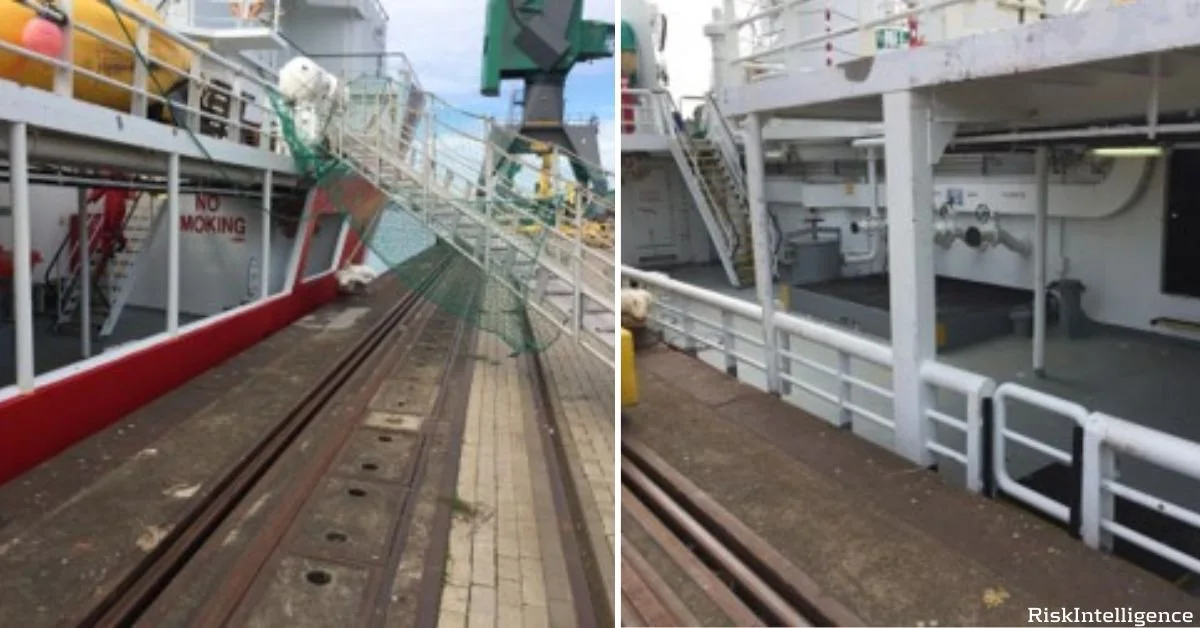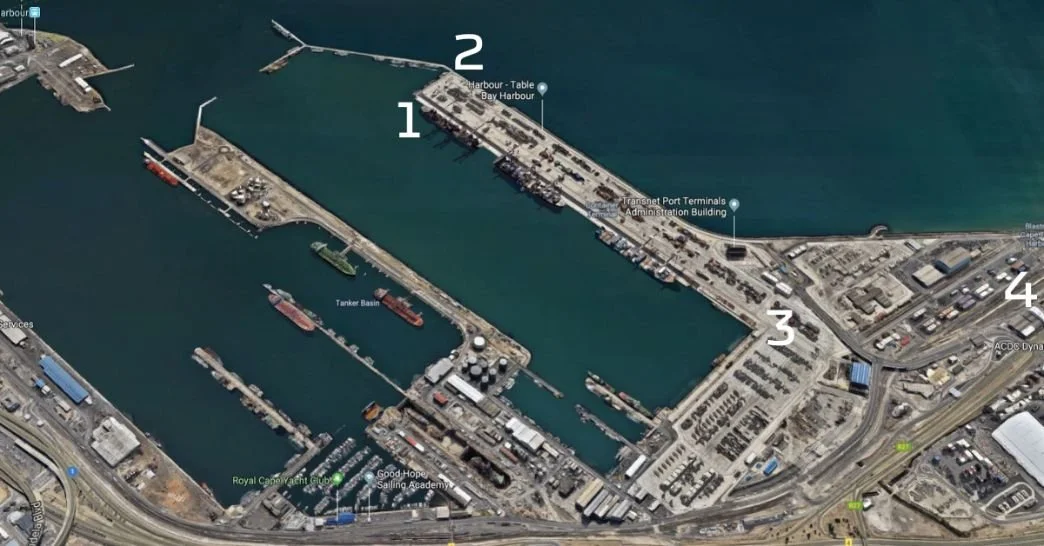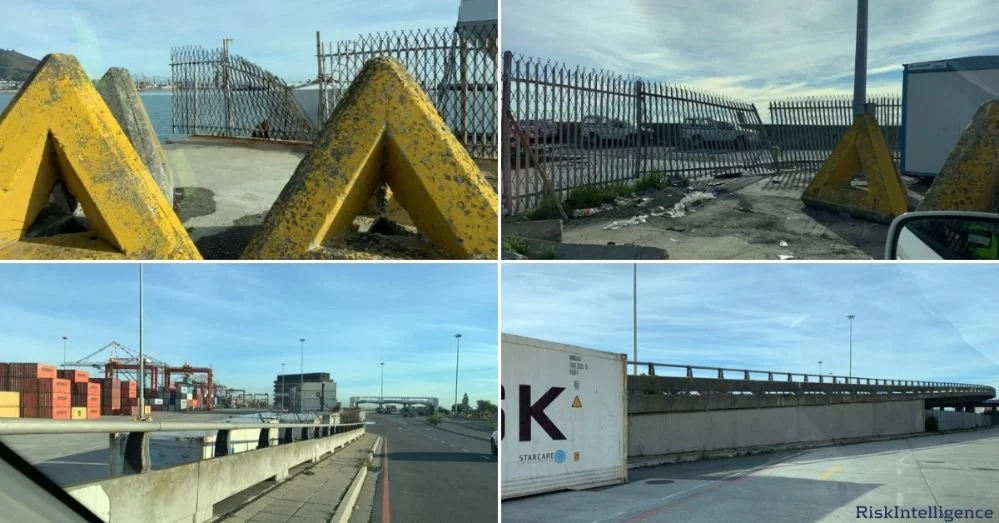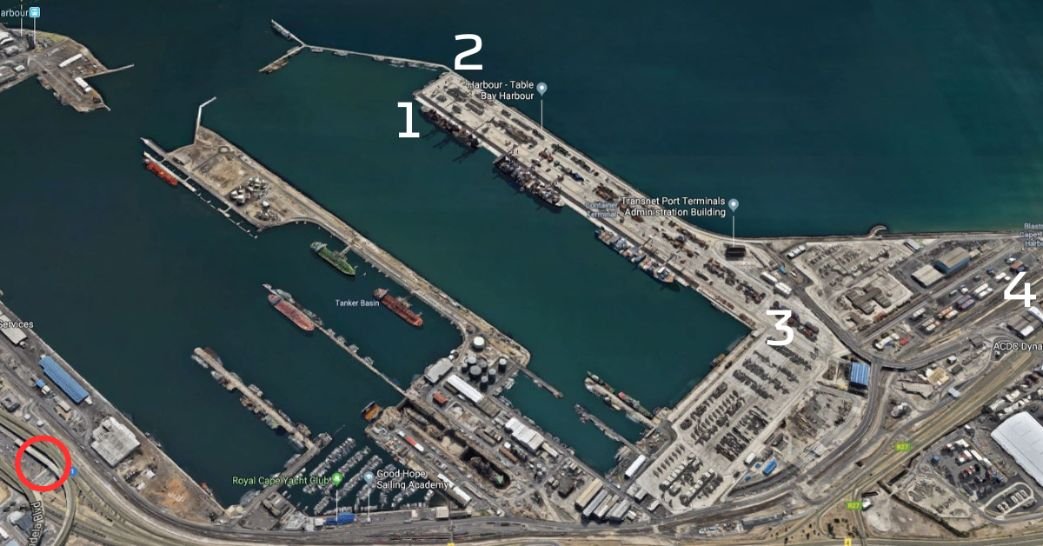Port weaknesses: Mitigating against the risk of stowaways
What is the risk of stowaways in South African ports and how can you mitigate against this when a port has security weaknesses?
We take an in-depth look at a specific South African port that is notorious for stowaways, but the methodology and insights are applicable to any port visit.
We'll look at how the code is laid out, give a few requirements and responsibilities where the majority of stowaways embark, look at one specific port’s areas for improvement, and discuss some of the recommended stowaway discovery measures on your vessels. Some of the relevant factors are highlighted in the ISPS code's ship security assessment sections.
Definition for a stowaway
“A person who is secreted on a ship, or in cargo which is subsequently loaded on the ship, without the consent of the shipowner or the master or any other responsible person who is detected on board the ship after it has departed from a port, or in the cargo while unloading it in the port of arrival, and is reported as a stowaway by the master to the appropriate authorities”.
Convention of Facilitation of International Maritime Traffic, 1965.
How may the risk of stowaways be prevented or mitigated? How should security assessment aspects of the ISPS code be implemented?
Ship Security Assessment (SSA) ISPS Code B
structural integrity;
knowledge of current security threats and patterns;
recognition, on a non-discriminatory basis of characteristics and behavioral patterns of persons who are likely to threaten security;
techniques used to circumvent security measures;
unauthorised access or use, including presence of stowaways;
Company Security Officer (CFO) is responsible for ensuring that a SSA ISPS Code B, the ultimate responsibility for ensuring that they are properly performed remains with the CSO.
Are you familiar with old twin deck compartments and upper deck areas? Do you know where the potential access points and hiding locations are?
We must stay current on issues affecting vessels when they are alongside or a tanker in particular ports. It is essential to be aware of a modus operandi, or MO, that is specific to certain ports, such as forged documentation disguised as stevedores or hidden in cargo, a port that provides easier access, and corruption amongst port security and officials.
According to the code, the CSO is not obliged to undertake these checks in person. However, the CSO is ultimately responsible for ensuring that they have been executed.
Proficiency in Designated Security Duties (PDSD)
All seafarers should have PDSD, or proficiency in designated security duty checks. Every member of the crew is expected to perform a security-related duty in accordance with the ship's security plan. Section 8 of part B of the ISPS code should be studied by any seafarers who do not believe they have a security-related duties. However, each vessel is individual and some are more accessible than others. When responding to the SSA, both safe navigation and emergency response are available.
The SSA should examine each identified point of access, including open weather decks and evaluate its potential for use by individuals who might seek to breach security. This includes points of access available to individuals having legitimate access as well as those who seek to obtain unauthorised entry.
Which ports do we have in the Risk Intelligence System?
The figure below is based on information provided by P&I clubs. Except for Bilbao, which is in the process of being added to the System, all of the top 10 ports in the graph's lower - left corner are currently integrated into our system.
Currently, Bilbao-bound vessels entering the port of Liverpool must pass through a lock before entering the port. Prior to entering the port of Liverpool, any Bilbao-bound vessel is now routinely detained in the lock while a canine search is conducted. This is because the improved fence at the Bilbao ferry port has driven potential stowaways to the commercial port there. Hence, security has been implemented at the ferry port.
South African ports
Cape Town, South Africa was used in this article as an example.
Cape Town, Durban, Lagos, and other African ports are widely acknowledged as the primary embarkation points for stowaways. Africa and her ports experience the most stowaway embarkations on a regular basis. In June of 2019, a Risk Intelligence analyst travelled to Cape Town and talked with a local contact interested in drug stowaways at Cape Town.
P&I clubs warnings about stowaways in South Africa
The number of persons trying to stowaway on board ships in Durban and Cape Town is increasing. Shipowners are recommended to implement appropriate preventative measures;
No person without a Transnet National Ports Authority (TNPA) permit should be allowed aboard. If an individual without a special permit arrives as part of a stevedore team, the stevedore foreman should explain why that person does not have a permit and the crew should then take a picture of the stevedore, together with the stevedore foreman, as evidence.
TNPA permit
In order to obtain a TNPA permit, individuals should view a 35-minute health and safety briefing. I attended the briefing, was assigned the chip that was handed to the class, and was issued the permit. As long as it is displayed on your high-visibility vest and you wear safety shoes and a hard hat, you are allowed to move freely throughout the entire port.
Transnet, the company that operates entire African ports, charges some of the highest costs. What do you get for your money in terms of security when you pay them? As we mentioned above, we’ll analyze the Cape Town port.
The image features the locations of four important possible breach points identified during our analyst’s visit. They are all easily rectified and they've all been reported to the Port Authority.
We’ll briefly describe the port of Cape Town for those who are not familiar with it. On the left side of the image, general cargo and stores, berths and warehousing facilities can be seen. Between numbers 1 and 2, there is a container tanker. The fruit terminal can be found further to the right, around number 3. A large refrigerated storing facility for fruits, which is one of the primary commodities traded at the Cape Town port.
The two images at the top of image axis one and two are at the container terminal's southern tip and clearly indicate breaches in the terminal fencing. There is also a driveway that leads down to the Y-shaped fishing pier. The bottom two images show the approach road to the container terminal's entrance. The road slopes down towards the gate, and it's easy to climb over the rusted coil of razor wire that runs the entire length of that wall.
Escape route 1
The potential stowaway waits beneath road bridges and pedestrian crossings, and everyone walks into the neighborhood near the intersection of Nelson Mandela Boulevard and Christian Bernard Street. It's right outside one of the access gates. And it's only 500 yards from Cape Town's key business areas. The area where they tend to gather is indicated by the red circle in the lower left corner of the following image.
There are several groups of people who are building a community. You may view vessel names and the regular circuits on which they call the ports, circuit, days, and hours, as well as the colours of coveralls that correspond to particular vessels and organisations. All of this information is written on the concrete pillars which support the bridge.
Escape route 2
The next easily identifiable point on the image is number four, which is slightly outside the port boundary. The wall shown in the image is a gas station on the main road, right next to the port boundary. You can observe how using the tree can affect the access to the port. On the image's right side, there are spikes in the wall. Looking down the left end of the wall by the railings, it’s noticeable that the spikes have been hammered flat for 12 to 18 inches. Hammering those spikes flat must have taken considerable work and would have made a lot of noise.
Private warehouses and facilities in the ports, such as the Sailing Academy and the Yacht Club, have improved security with proper signs, well-maintained, recently acquired perimeter equipment, cameras, and gates. People in and around Cape Town verified that this was due to higher budgets and wages than those paid by Transnet and the national entities.
During extremely harsh or stormy weather, certain bridge locations in and around the port become more appealing to potential stowaways. Dense fog or mist, which occurs frequently in Cape Town, provides more options to access the port premises on site. Although there is CCTV or sections with CCTV, the fog, mist, and heavy rain make it considerably easier for potential stowaways to gain access to the port premises.
What should your vessel do on discovery?
contact flag, vessel operators and agent at NPOC;
vessel owners contact P&I as soon as possible;
master should have P&I correspondents details so he can contact them at next port
declare them at every port whilst they’re onboard;
in a lot of countries you will receive no assistance getting them off, then you have to keep notifying the immigration officials at each subsequent port;
ensure they’re treated humanely, consistent with the basic principles; are not forced to work on board, except in emergency situations or in relation to their accommodation;
Search - question - photograph - document
When a stowaway or stowaways is discovered, measures should be taken during any personal searches, and there should always be a number of crew present in case the stowaway or stowaways turn violent or offer violence. Your particular flag will provide you with a report template for the master.
During the questioning, you should always try and establish three things:
the port of embarkation;
the nationality of the stowaway;
the identity of the stowaway.
Ship's security protocol breach
The discovery of a stowaway indicates a breach in ship security. As such, stowaway incidents should be reviewed to identify the root cause(s) of the security breach and the actions necessary to prevent reoccurrence, such as amending the SSP and implementing additional security measures.
Port State authorities have detained vessels entering port with stowaways for being in violation of the ISPS code. External audits of the SSP and other actions may be required in order to lift the detention. Some authorities have also imposed requirements that the company hire private security guards for the duration of the vessel’s port call when stowaways are found aboard.
In the worst-case scenario, someone has colluded or even helped the crime. For any reason, port authorities are likely to impose sanctions. As usual, certain poor state authorities refuse to aid in the disembarkation of stowaways. If they are unable to disembark, the operator will incur a cost. If someone is discovered on the vessel, they will be declared a stowaway rather than a trespasser and fined, along with repatriation fees.
Stowaway disembarkation fines in Cote D’Ivoire
The example you see below is Cote D’Ivoire, the Ivory Coast. In the UK, a fine of £2,000 per stowaway is imposed to reduce the penalty and it can be mitigated, but the vessel must be able to prove that proper security measures are in place on board, and were in place at the port of embarkation. Evidence that extensive stowaway searches were conducted at previous ports should also be submitted. It's also essential to note that this must be documented as a 'search for stowaways' in the vessel's log.
Example: “Abidjan port authorities issued a circular to all agents advising that any vessel calling Abidjan with stowaways to disembark will be subject to an XOF 2 million (approx. €3,000.00) fine, per stowaway.”
The fine will be imposed on the ship regardless of where the stowaway(s) may have embarked. Furthermore, due to an increase in the number of stowaways found onboard vessels arriving from the port of Tema (Ghana), in order to be allowed to berth in Abidjan, any ship incoming from Tema will first have to remit an official "Search Certificate" to be issued by the Port of Tema authorities.
Stowaways discovered in Cape Town, August 2019
As an example, these three stowaways were identified during a canine check of the vessel prior to departure from Cape Town. That was the first time the novice search crew had discovered stowaways in the communications antenna. They were fortunate that the device was not activated, but this incident shows the risk of leaving any area that could be considered a hiding space unlocked while on board. You must also consider the affects on the crew member who discovered them if they had spent a few days in the antenna if it had been secured and left unchecked prior to departure.
Another example, reported by a client when a stowaway was discovered, he was wearing multiple boiler suits from different companies. Eventually, he was discovered in a starboard lifeboat after being in the chain locker. He embarked the berth on a rope and went down through the horse pipes since the covers were not properly secured. There are two easy and routine tasks for any seafarer onboard a vessel if there are appropriately and properly equipped rack guards that would have prohibited him from climbing the berthing ropes. If the horse-pipe covers were securely attached, that again might have prevented him from accessing the vessel.
Mitigation of incident
It's important to stress that you can only really mitigate against these incidents. A determined person will find a way of getting on board the vessel. Therefore, you have to present an outward appearance of preparation so that your vessel isn't the one that they choose to embark.
It is critical that the CFO is aware of threats in certain ports and reports them to the SSL. Personnel in charge of security ashore and in the office should be informed of potential risks to their vessels and crews in different ports, and this information should be relayed to the vessel as soon as possible.
One way of keeping abreast of the various categories of threat which affect many ports and their associated cities, would be to have access to our Risk Intelligence System. Here you can see the Elevated level we have for Stowaways in the port of Cape Town. We currently have threat assessments for 242 ports and offshore terminals (July 2021).
Common hiding places
unlocked lockers, void spaces, empty drums or under the containers;
rudder trunk spaces (especially when ship is in ballast condition);
ventilation trunks (especially in Ro-Ro Car Carriers);
false ceilings/deck-heads.
Prevention measures
CSO awareness of threat in specific ports;
passing that onto the SSO;
all doors, hatches and access to holds or stores, which are not used during the ship’s stay in port should be secured;
Shoreside access points to the ship should be kept to a minimum and be adequately secured;
Waterside access areas, seaward of the ship should be adequately secured;
all persons coming aboard should be required to present a valid permit. No permit - no access.
These are some of the preventative measures you should have on board your vessel:
communication should be provided and tested;
ability to floodlight deck and overboard should be maintained;
sufficient night lighting should be available between decks and along the hull;
the importance of documentation when searching the vessel's log for stowaways;
remember to repeat this process every 48 hours and document it.
Prior to departure
before departing a port (any port) all vessels should carry out a thorough search of all compartments and areas;
the procedure for this search should be documented as a ‘search for stowaways’ and should form part of the SSP;
search methods which might harm any stowaways should not be used;
in some ports consideration should be given to engaging specialist K9 search teams.
Stowaways are extremely expensive and difficult to disembark. Based on discussions with P&I representatives, you're looking at a minimum of 40,000 USD, with the possibility of going up to and occasionally exceeding 300,000 USD, depending on the complexity of getting these folks repatriated. Unexpectedly, South African ports were formally recognised for their security excellence at the end of 2019. Fortunately, it was conducted by their own Department of Transportation, rather than by an internationally recognised professional standards organisation.
FAQ:
-
The crews are busy and crew numbers have been reduced whilst roles and responsibilities have increased. Outward preparation is extremely important: if you're looking to target anything, you go for the weakest link. So, when you get along side, you apply the rat guards properly. I've got some imagery of rat guards, which have just been hung over, haven't been properly secured, haven't been tied off. And that would be a major preventative measure, the mitigation measures for climbing up mooring ropes, things like the hose pipe covers can be attached and properly dogged. Thereby, you can't open them from inside the hose pipe itself.
-
You're seeing more of it now. It appears to be mostly for narcotics, but also for stowaways. And the advantage of canines is that they can get into places that we cannot, even if people of other ethnicities are built differently. That is an excellent mitigation.
Again, this should always be noted in the log. If the port state authorities review your vessel log and notice that you've hired a canine to seek for stowaways, you're increasing your degrees of mitigation.
-
Whilst you are alongside, at night, then floodlight the vessel foot, the area out immediately surrounding the vessel. That adds to the professional look, and that outward appearance of preparedness and vigilance.
On departure from or prior to departure, you can ask the pilot boat if he can do a once around, you can contract a security vessel or an escort vessel to do a once around the vessel. Check in on the road or in the trunk in your vessel search for stowaways. Note it in the ship's log as a search for stowaways – I can't highlight that enough. It must be conducted thoroughly.
-
It's desperate people trying to get to a better place. There is an increase in the so-called professional stowaways. And these guys are the ones who are using established contacts with imports authorities.
So, they're the ones who know when to get in and what vessels to get on.
You also can't discount the levels of crew collusion at some point. And that's something that's also an issue. But these are the guys who will get on board, and hide themselves sufficiently well. And then once the vessel has sailed, will make themselves known as a stowaway and there'll be compliance. They'll sit in the cabin, that you provide for them, on their own, quite happily. And then when they get off, then they'll perform, and they will either off or chose violence.
They will make all kinds of excuses once they're off the vessel because they know that your vessel has to stay alongside until they're back home repatriated. They won't do that, initially, they'll get to the airport, and then they'll argue with airport security staff or with the agent who takes them there. Almost to a point where the airline will refuse to board them.
-
You have obligations once you have them on board. And you obviously have to treat them not as mischief guests, but you have to treat them humanely. You can't put them to work. You place them in a cabin, you feed them and water them, offer them clean clothes, usually just a clean pair of overalls. But you remove anything that they could use as A: a weapon or B: as an implement for self-harm.
Especially with the current COVID-19 issues, these guys are going to be sitting on board and again, they're going to be a risk to your crew. All the more impetus or incentive to make your vessel the one that looks prepared and vigilant.
LEARN MORE:
Want 24/7 access to unrivalled intelligence? Get a free trial of the Risk Intelligence System:
Sign up for a two-week unlimited free trial of the Risk Intelligence system for up to five users, which includes access to all incidents, assessment reports, and features from a vessel or a desktop.









